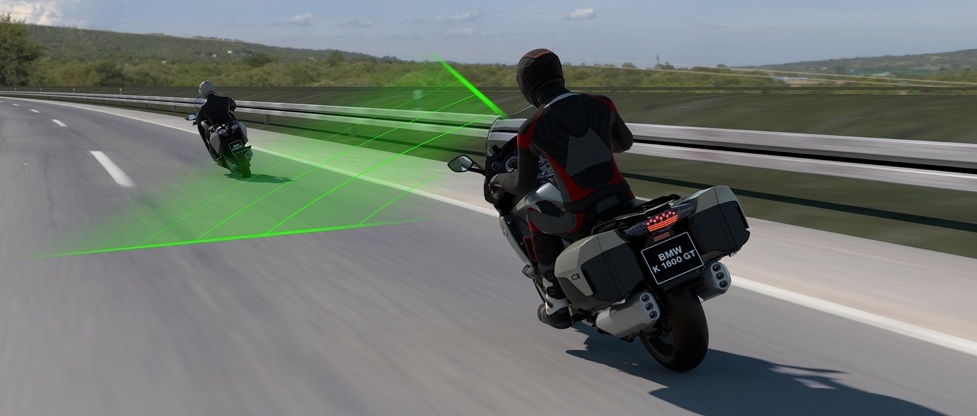Developed in cooperation with Bosch, the new ACC system takes the unique dynamics and safety aspects of two-wheelers into account.
BMW has released details about its new Motorcycle Active Cruise Control (ACC), bringing a popular automotive convenience feature to the two-wheeled realm. The new system, developed in cooperation with Bosch, is expected to debut on various BMW models in 2021. Similar systems are expected in 2021 from Ducati and Kawasaki. ACC relieves the rider from having to manually adjust to the speed of the vehicle they are following when the cruise control is set, automatically regulating the motorcycle’s speed to maintain a set distance.
The new setup provides three following distances, and can be engaged at speeds between 20 and 100 mph (30-160 kph). The new ACC system also provides two modes – comfortable or dynamic – to determine the aggressiveness of the acceleration and deceleration. Tailored to the motorcycle experience, cornering speeds can be reduced automatically to maintain comfortable lean angles. As lean angles increase, the system’s braking and acceleration dynamics are limited to maintain stability.
Unlike many automotive ACC systems with “Stop and Go” capabilities, the BMW Motorcycle ACC system only responds to moving vehicles. The rider is still fully responsible to intervene should a need for heavy braking occur, as emergency levels of braking without the rider being prepared could prove disastrous. Stationary vehicles – such as those approached when closing on a line of stopped traffic or at traffic lights – are not considered by the system, and familiarity with its functions will be crucial for new owners.
Radar-based setup
The BMW ACC system determines distance to the vehicle it’s following via a compact radar sensor installed in the front of the motorcycle, and ACC functionality is distributed across several control units. Objects are detected by the radar sensor, which uses the motorcycle’s yaw rate and speed to determine vehicle path, a corridor in which the motorcycle will move in the next 100m. If an object is detected within that path, the system responds to adjust to the set distance.
The radar sensor sends target accelerations via a CAN bus connection to the bike’s ABS system, which requests drive torque from the engine, or braking torque from the brake system. During cornering, speed can be reduced to maintain a limited lean angle. Also, since the radar’s effectiveness is reduced while the motorcycle is leaned over, the system will prevent mid-corner acceleration if it loses “lock” on the vehicle being followed.
For upcoming BMW models, the ACC controls will be mounted on the left handlebar, and the system will provide a traditional “set-speed” cruise control option. System status icons and “take-over” warnings will be provided in the main display. The system will work to maintain set speeds on descents and the rider can override the set speed with the throttle. The ACC will automatically deactivate if the brakes are applied or the throttle is closed past the zero position.
Pressing the Set/Res button applies the current riding speed, which can be adjusted in 1 mph-km/h increments with a short press, or 5 mph-km/h increments with a long press. Holding the button will increase/reduce the set speed in 5 mph-km/h steps. You can still shift gears while maintaining ACC, as long as you’re using the available quick-shifters, or don’t hold the clutch lever in for more than 1.5 seconds.
Motorcycle-specific challenges
Seasoned riders may bemoan the very idea of ACC on a motorcycle, but BMW seems to have extensively considered the unique environment of riders. All takeover requests (TOR) on BMW models will arrive via “conspicuous red symbols” in the instrument-cluster’s TFT display. TOR warnings activate at two different levels. TOR1 is displayed when ACC control is disabled when a vehicle is detected in front of the motorcycle. Riders will need to intervene to ensure a safe distance is maintained. Another example would be if the vehicle speed drops below 18 km/h (11 mph), and ACC is deactivated to avoid stalling the engine.
TOR2 is displayed if the system detects a dangerous situation in which the distance control can’t ensure the required minimum distance even at the maximum-permitted brake-actuation level. ACC will continue to brake the motorcycle, but the rider is expected to engage additional braking force if necessary to avoid a collision. BMW sensibly notes that ACC supports a “calm riding style,” and recommends riding in the middle of the driving lane behind the vehicle being followed to help ensure system effectiveness.
The system will stay engaged while overtaking if the turn-signal indicators are used, which activates an “overtaking assistant.” This provides a swifter deselection of the object in front as well as an earlier selection of a new vehicle, but BMW recommends moving out of your lane decidedly in order to support deselection of the vehicle in front of you. After overtaking, they also recommend returning to your lane as swiftly as possible to provide the radar sensor the maximum amount of time to detect a new vehicle.
BMW noted the greatest technical challenges overcome in developing the ACC system for motorcycles versus automotive was due to the more pronounced pitch, roll and yaw movements, and the resulting inclinations in the radar detection field. It also pointed out that more measured variables are available for passenger cars to determine the predicted driving lane, which in the case of motorcycles, is much narrower. Since motorcycles do not need to stay centered in their lane, target/object selection/deselection also gets more nettlesome.
Source: https://www.sae.org
CUT COTS OF THE FLEET WITH OUR AUDIT PROGRAM
The audit is a key tool to know the overall status and provide the analysis, the assessment, the advice, the suggestions and the actions to take in order to cut costs and increase the efficiency and efficacy of the fleet. We propose the following fleet management audit.




